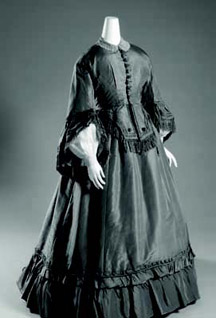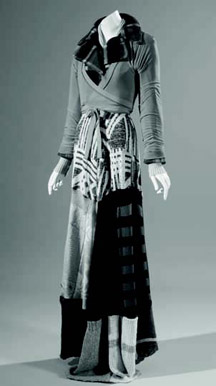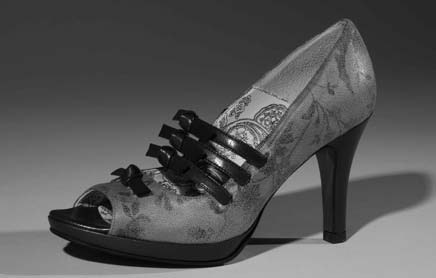About the Exhibition

Day dress, poisonous green silk faille and green chenille, circa 1865, USA, museum purchase.
Eco-Fashion: Going Green (May 26 - November 13, 2010) defines "eco-fashion" as the work of environmentally-conscious designers who use, produce, and/or promote sustainable and ethical products. Eco-fashion can also be understood as the fashion industry's response to the global environmental crisis. However, despite its increasingly common usage, the term remains without standard definition. It is used—often interchangeably—with terms such as "green" and "organic," and a general absence of environmental standards within the fashion industry adds to the confusion over precisely what "eco-fashion" means. Conscientious consumers must carefully research the practices of fashion labels in order to differentiate those that observe environmentally and socially responsible principles from those that do not.
A number of obstacles face designers and manufacturers who seek to implement environmentally friendly practices. As Sandy Black, author of Eco-Chic: The Fashion Paradox, notes, "At all stages of design and production decision-making there are trade-offs to be made, reconciling fashion and style with available materials, costs and time constraints." For example, there are fewer suppliers of "eco-friendly" materials, and only a small fraction of all cotton is grown and produced organically. Even local production—often touted as a model solution—is often perceived as too inefficient to turn a profit.

XULY.Bët, recycled dress and jacket ensemble, multicolor sweaters, brown wool plaid, red nylon, fall 1994, France, gift of XULY.Bët.
Although eco-fashion has become an integral part of industry vernacular, some, like Black, insist that it is inherently paradoxical. Fashion is guided by a cycle of style change, in which the old is rapidly replaced by the new. The latest fashion trend often holds substantial appeal for a shopper. The desire to be current may eclipse any real consideration of the conditions under which a garment was produced.
So how does sustainability fit within such a system of planned obsolescence? The "fast fashion" cycle has become so established that many wonder whether it is fundamentally possible to change patterns of consumption. In contrast, "slow fashion" could provide considerable benefit to the environment. However, altering the way we consume fashion may not be without negative ramifications: across the globe, millions of livelihoods depend upon the constancy of change in fashion. These challenges, and many more that confront the fashion industry, will not be easily or quickly overcome.
19th century
Designers today face problems that date back to the nineteenth century, when technological developments resulted in fast, inexpensive textile production that sometimes yielded inferior products. By the end of the 1800s, mass-produced clothing had become more prevalent. This escalated into the manufacture of cheap, disposable garments—a practice that has now become something of an industry standard. Many such garments—which sustainability experts estimate are worn an average of just six times—end up in landfills.

Charmoné, Cézanne pump, tan and red microfiber faux leather, 2010, USA, gift of Lauren Carroll and Jodi Koskella of Charmoné.
1900 - 1940
Problems related to fashion production increased throughout the twentieth century. By the 1940s, numerous designers were experimenting with synthetic fibers, many of which will take hundreds of years to biodegrade. "Natural" fibers, especially cotton, were grown with large amounts of chemical fertilizer and pesticides, polluting both soil and water supplies. Despite ethical concerns, animal products, especially furs, became increasingly fashionable luxury commodities, and throughout the United States, garment workers' unions formed to promote fair wages and healthy work environments. This has prompted an outsourcing of production to thirdworld countries, where workers are paid very little and labor conditions are often dangerous.
1950 - 1970
The need for significant change in fashion production became more widely recognized in the 1960s. Often viewed as the foundation of the environmentalist movement, Rachel Carson's book, Silent Spring (1962), specifically referenced the use of pesticides in fiber growth, as well as the damage caused by fabric finishes. By the end of the decade, the "natural" look of the hippies was associated with environmentalism. Several elements of the hippies' clothing choices—earth tones, hemp fabric, and patchwork, for example—are considered prototypes for some of today's eco-fashion. Many of today's chic styles, however, are a far cry from their earthy 1970s counterparts.
1980 to Today
As environmental problems (and their possible solutions) have evolved, so has eco-fashion. Today, there are a number of ways to "go green." While the choice of organic fabrics seems an obvious method, others, including "investment" purchases of high-quality, long-lasting goods, are perceived as a way to slow consumerism. No matter the approach, the challenge for designers is to provide sustainable fashions that are affordable, diverse, and accessible—and to do so without compromising aesthetic value. However difficult that may be, eco-fashion provides opportunities for new, creative approaches to design, and industry experts feel optimistic about its future.
In October 2009, Women's Wear Daily reported that consumers are "ready to go eco." Increasingly, designers and fashion executives have implemented "green" initiatives, helping to broaden the reach of eco-designs. Once viewed as a trend, eco-fashion today is widely considered an influential part of the environmentalist movement. Eco-Fashion: Going Green intends to further the examination and discussion of fashion’s relationship with the environment—past, present, and future.